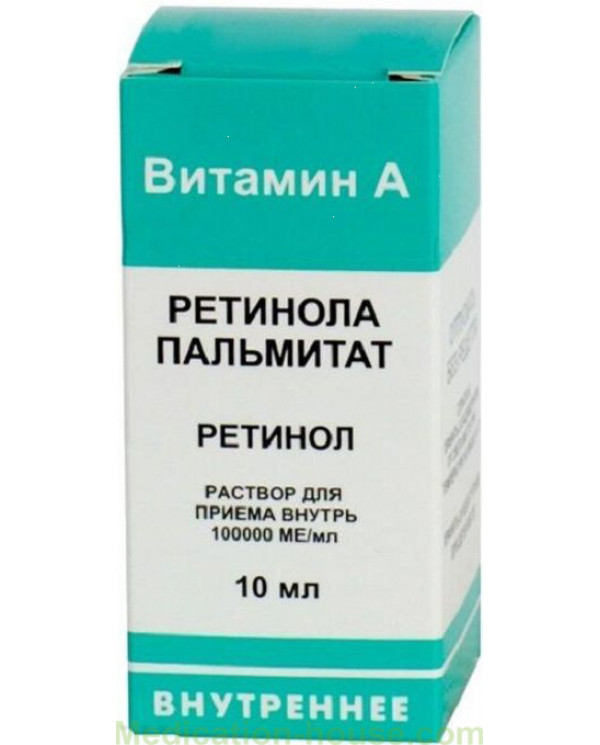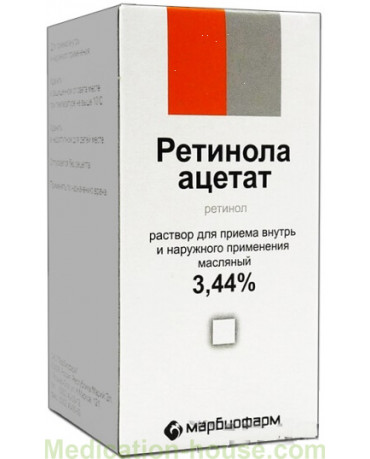Instruction for Retinol Palmitate
You can buy Retinol Palmitate here
Composition
active ingredient: retinol palmitate (vitamin A) (in terms of 100%) - 55.1 g.
excipients: butylhydroxytoluene, butylhydroxyanisole, rapeseed oil up to 1 l.
1 ml of the solution contains 100,000 IU (1 drop of the solution from a dropper or an eye dropper contains 3300 IU). 1 mg of retinol palmitate corresponds to 1817 IU.
pharmachologic effect of Retinol Palmitate
Vitamin A has a fortifying effect, normalizes tissue metabolism, participates in redox processes (due to a large number of unsaturated bonds), in the synthesis of mucopolysaccharides, proteins, lipids, in mineral metabolism, cholesterol formation processes. It enhances the production of lipase and trypsin, enhances myelopoiesis, cell division processes. It has a positive effect on the function of the lacrimal, sebaceous and sweat glands; increases resistance to diseases of the mucous membranes, respiratory tract and intestines; increases the body's resistance to infection. Strengthens the division of epithelial cells of the skin, rejuvenates the cell population, inhibits keratinization processes, enhances the synthesis of glycosaminoglycans, activates the interaction of immune cells between themselves and the cells of the epidermis.
Stimulates cell regeneration. Participates in photoreception processes (contributes to human adaptation to the dark). Local action is due to the presence of specific retinol-binding receptors on the surface of epithelial cells.
Indications for use
Hypovitaminosis, avitaminosis A. In the complex therapy:
infectious and inflammatory diseases (measles, dysentery, influenza, tracheitis, bronchitis, etc.),
lesions and skin diseases (fissures, ichthyosiform erythroderma, acne, hyperkeratosis, seborrheic dermatitis, psoriasis, neurodermatitis, some forms of eczema, skin tuberculosis),
eye diseases (retinitis pigmentosa, hemeralopia, xerophthalmia, keratomalacia, eczematous eyelid lesions),
gastrointestinal diseases (erosive gastroduodenitis, gastric ulcer and duodenal ulcer),
cirrhosis of the liver.
Assign to prevent the formation of stones in the biliary and urinary tract.
Contraindications
Hypersensitivity to the components of Retinol Palmitate, hypervitaminosis A, pregnancy, gallstone disease, chronic pancreatitis, acute inflammatory skin diseases. To be used with caution in nephritis, heart failure II-III century, alcoholism, viral hepatitis, renal failure, old age, childhood.
Pregnancy and lactation
It is not recommended to take Retinol Palmitate during pregnancy and breastfeeding.
Dosage and administration
The use of Retinol Palmitate should be under the supervision of a physician. The drug is taken orally after a meal early in the morning or late in the evening.
Therapeutic doses for adults with mild to moderate avitaminosis are up to 33,000 IU / day, for children, 1,000–5,000 IU / day, depending on age.
In case of eye diseases, adults are prescribed - 50000-100000 IU per day and at the same time 0.02 g of riboflavin.
In dermatology, in the treatment of acne and ichthyosiform erythroderma in adults, 100000-300000 IU / day, children, 5000-10000 IU / kg per day. In case of skin diseases, adults are prescribed per day by 50,000-100,000 IU of retinol palmitate.
In gastroenterology - 50,000 IU per day. Single doses of retinol palmitate should not exceed 50,000 IU for adults and 5,000 IU for children. Daily doses for adults are 100,000 IU and 20,000 IU for children. For the treatment of acne and ichthyosiform erythroderma in adults 100000-300000 IU.
Side effects
Some patients with long-term admission observed dry skin and mucous membranes, increased sensitivity of the skin of the face, zaedy. These phenomena pass on their own with a dose reduction or temporary withdrawal of Retinol Palmitate.
In the treatment of acne after 7-10 days of administration, an exacerbation of the local inflammatory reaction is observed, which does not require additional treatment and then stops. In some cases, there is intolerance to Retinol Palmitate, which requires its cancellation.
Overdose
Long-term daily intake of vitamin A (100,000 IU - children, 200,000 IU - adults) can cause intoxication, hypervitaminosis A. Symptoms of hypervitaminosis A in adults - headache, drowsiness, lethargy, flushing of the face, nausea, vomiting, tenderness in the bones of the lower extremities, impairment gait. Children may experience: fever, drowsiness, sweating, vomiting, skin rashes. If symptoms of overdose occur, Retinol Palmitate should be withdrawn. Excess retinol palmitate is eliminated from the body by ingesting alcohol. When pronounced symptoms of intoxication should be administered inside glucocorticosteroids.
Interaction with other drugs
During long-term tetracycline therapy, it is not recommended to prescribe vitamin A (the risk of developing intracranial hypertension increases).
Salicylates and glucocorticosteroids reduce the risk of side effects.
Kolestiramin, Kolestipol, mineral oils, neomycin reduce the absorption of vitamin A (you may need to increase the dose).
Oral contraceptives increase the concentration of vitamin A in plasma.
Isotretinoin increases the risk of a toxic effect.
Vitamin E reduces toxicity, absorption, deposition in the liver and the use of vitamin A; high doses of vitamin E can reduce the supply of vitamin A in the body.
Weakens the effect of calcium preparations, increases the risk of hypercalcemia.
special instructions
Do not take at the same time multivitamin complexes containing vitamin A, in order to avoid overdose.
Storage conditions
In the dark place at a temperature of no higher than 10 ° C. Keep out of the reach of children.
Shelf life - 2 years. Do not use after expiration date.
Terms of sell
You don't need a prescription to buy Retinol Palmitate.


